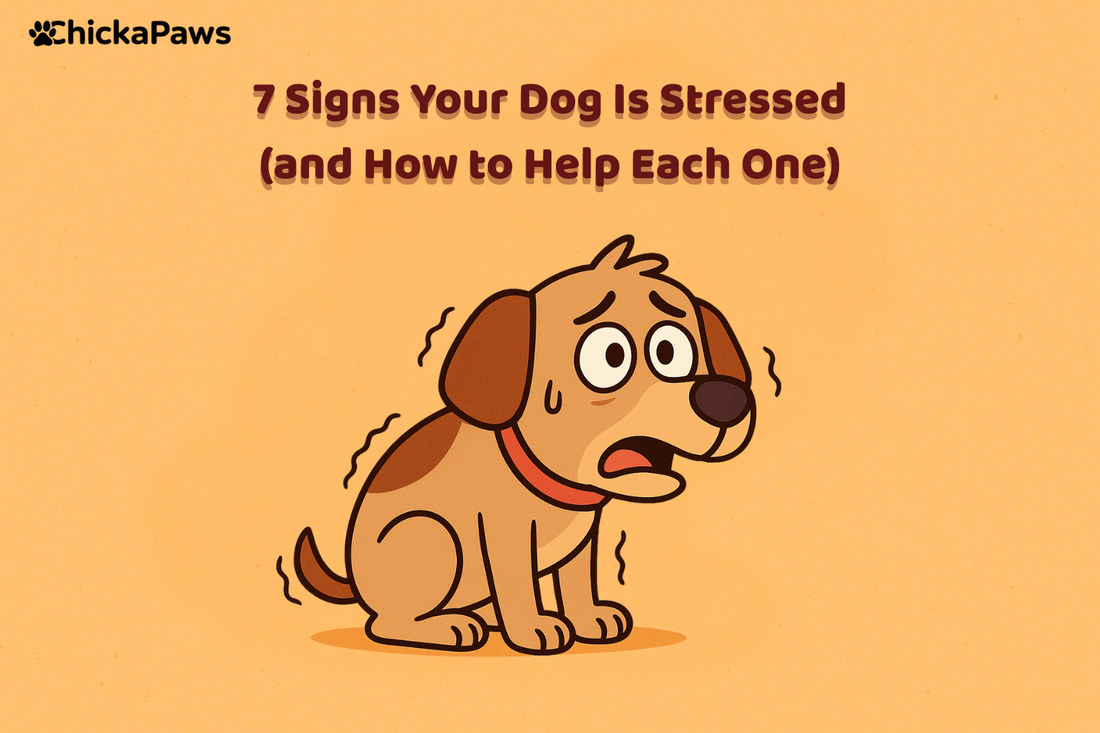
🐶 7 Signs Your Dog Is Stressed (and How to Help Each One)
Share
When Your Dog’s Body Speaks Before Their Bark
Dogs may not use words, but their bodies speak volumes. A flick of the ear, a lowered tail, or restless pacing can reveal more than a thousand barks ever could. When your usually cheerful pup becomes distant or clingy, they’re telling you something important: “I’m not okay.”
Stress in dogs is far more common than many owners realize. Recognizing the early signs can prevent long-term anxiety and even physical illness. Below are seven key stress signals—and exactly how to help your pup feel safe, calm, and loved again.
1. Excessive Panting and Drooling
When it’s not hot, and your dog pants heavily or drools without reason, stress may be the culprit. Anxiety increases heart rate and body temperature, triggering panting even in cool environments.
How to Help:
-
Move them to a quiet, cool space with airflow
-
Offer clean water (stress dehydrates quickly)
-
Use calm tones; avoid sudden gestures or shouting
-
Play soothing background music or white noise
💡 Pro Tip: Keep a cooling mat handy for anxious moments.

2. Trembling or Shaking
Not every shake means “cold.” Dogs often tremble when scared or overwhelmed by loud noises, car rides, or new faces.
How to Help:
-
Try a thunder shirt or compression wrap
-
Sit nearby and speak softly
-
Let them come to you—don’t force comfort
-
Use pheromone sprays (like Adaptil) before stressful events
💬 Training Tip: Slowly expose your dog to mild versions of the trigger while rewarding calm behavior—this builds confidence over time.

3. Pacing or Restlessness
If your dog can’t settle down and keeps pacing, it’s often due to built-up energy or emotional tension.
How to Help:
-
Keep a consistent schedule for walks and meals
-
Offer puzzle toys or sniffing games
-
Maintain predictable routines (dogs thrive on structure)
-
Try vet-approved calming supplements or chews
🎯 Goal: Transform nervous energy into healthy movement—not chaos.

4. Excessive Licking or Chewing
Constant licking of paws or furniture can be your dog’s way of self-soothing—like a human biting their nails. Over time, it can lead to raw skin or infection.
How to Help:
-
Check for allergies or skin irritation
-
Redirect with safe chew toys or frozen treats
-
Increase mental and physical playtime
-
Apply calming paw balm or dog-safe sprays
🦴 Try This: Fill a Kong with peanut butter and freeze it—keeps them busy and relieves anxiety.

5. Loss of Appetite
A sudden refusal to eat is often emotional, not stubborn. Anxiety affects digestion and appetite.
How to Help:
-
Keep mealtime calm and consistent
-
Hand-feed gently to rebuild trust
-
Add warm water or broth to enhance aroma
-
Visit a vet if it lasts over 48 hours
💛 Emotional Insight: Refusing food is often fear—not defiance.
6. Excessive Barking or Whining
When dogs bark or whine excessively, it’s usually a cry for reassurance. It may signal separation anxiety or overstimulation.
How to Help:
-
Practice short departures and return calmly
-
Leave a T-shirt with your scent nearby
-
Play soft TV or radio for background comfort
-
Use crate training as a “safe den,” not punishment
🚫 Never yell. Anger only amplifies fear. Calm repetition teaches security.
7. Hiding or Avoiding Eye Contact
If your dog suddenly hides, avoids eye contact, or curls up under furniture—it’s a clear cry for emotional space.
How to Help:
-
Respect their distance and let them come to you
-
Reward small moments of calm reconnection
-
Create a cozy “safe zone” with soft bedding and familiar toys
-
Use low lighting or calming scents like lavender
🏡 Remember: It’s their safe retreat, not a “timeout corner.”

Be the Calm They Need
Your dog doesn’t need a perfect owner—just a patient one. Each gentle touch, each calm word reminds them that the world isn’t scary after all.
Behind every bark or tremble lies a loyal friend who just wants to be understood.
Turn Stress Into Communication
When stress builds up, it’s often because dogs can’t express what they feel. Tools like PawTalking Buttons help bridge that gap—letting dogs “say” words like “outside” or “water.”
This not only reduces stress-driven barking but deepens your bond through understanding.
Why Pet Parents Love It:
-
Reduces anxiety through expression
-
Builds confidence in shy dogs
-
Strengthens emotional connection
-
Makes training fun
🎉 Special Offer: Save $20.01 today (only 80 units left!)
👉 Start Teaching Your Dog to Talk →
FAQ (Schema-Optimized)
Q1: Can dogs experience stress like humans?
Yes. Dogs release cortisol and adrenaline when stressed, affecting both mood and immunity.
Q2: Should I ignore my dog’s stress to make them stronger?
No. Ignoring fear reinforces it. Gentle reassurance builds resilience and trust.
Q3: How long does it take to calm a stressed dog?
It varies by trigger—some recover in minutes, others need consistent reassurance over days.
Q4: Are calming treats safe?
Yes, when vet-approved. Look for ingredients like chamomile, valerian, or L-theanine.
Q5: Can teaching communication reduce stress?
Absolutely. Tools like PawTalking Buttons let dogs express needs clearly, reducing frustration.
Q6: When should I see a vet or trainer?
If your dog shows aggression, self-harm, or loss of appetite beyond 48 hours, seek professional help.


